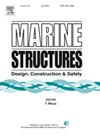海底电缆铝导体的热屈曲
IF 5.1
2区 工程技术
Q1 ENGINEERING, CIVIL
引用次数: 0
摘要
导体是海底电缆输电的关键部件。在电缆工作期间,电流的传输导致导体温度的升高。由于焊接产生的初始缺陷,接合处的铝导体在热载荷引起的压缩载荷作用下可能发生屈曲破坏。在本研究中,建立了一个有限元模型来研究导线在导体中的热屈曲,并在弹性阶段与理论公式进行了验证。有限元模型考虑了焊接效应,包括热影响区(HAZ)的机械强度折减、长度和初始变形。分析了导体导线的典型屈曲机理,并对焊接效应对其屈曲行为的影响进行了灵敏度分析。结果表明:热载荷作用下热影响区导线在塑性阶段发生了卡断屈曲;这种屈曲行为会导致HAZ内的位移和应力突然显著增加,从而可能导致结构破坏。临界屈曲温度和临界屈曲轴向力与热影响区机械强度折减幅度、长度和直线度呈负相关。本文章由计算机程序翻译,如有差异,请以英文原文为准。
Thermal buckling of aluminum conductors in submarine cables
The conductor is a key component in submarine cables for power transmission. During the operation of the cable, the transmission of current results in an increase in the conductor's temperature. Due to initial imperfections caused by welding, the aluminum conductor at the joint may experience buckling failure under the compressive load induced by thermal loading. In this study, a finite element model is developed to investigate the thermal buckling of the wire in the conductor, and the model is validated against theoretical formulas within the elastic stage. The welding effect is considered in the finite element model, including the mechanical strength reduction, length, and initial deformation of the heat-affected zone (HAZ). The typical buckling mechanism of the conductor wire is analyzed, and a sensitivity analysis of the welding effect on the buckling behavior is also conducted. The results indicate that the conductor wire in the HAZ undergoes snap-through buckling under thermal loading during the plastic stage. This buckling behavior causes a sudden and significant increase in displacement and stress in the HAZ, which may lead to structural failure. Moreover, both the critical buckling temperature and critical buckling axial force are negatively correlated with the magnitude of the mechanical strength reduction, length, and out-of-straightness of the HAZ.
求助全文
通过发布文献求助,成功后即可免费获取论文全文。
去求助
来源期刊

Marine Structures
工程技术-工程:海洋
CiteScore
8.70
自引率
7.70%
发文量
157
审稿时长
6.4 months
期刊介绍:
This journal aims to provide a medium for presentation and discussion of the latest developments in research, design, fabrication and in-service experience relating to marine structures, i.e., all structures of steel, concrete, light alloy or composite construction having an interface with the sea, including ships, fixed and mobile offshore platforms, submarine and submersibles, pipelines, subsea systems for shallow and deep ocean operations and coastal structures such as piers.
 求助内容:
求助内容: 应助结果提醒方式:
应助结果提醒方式:


